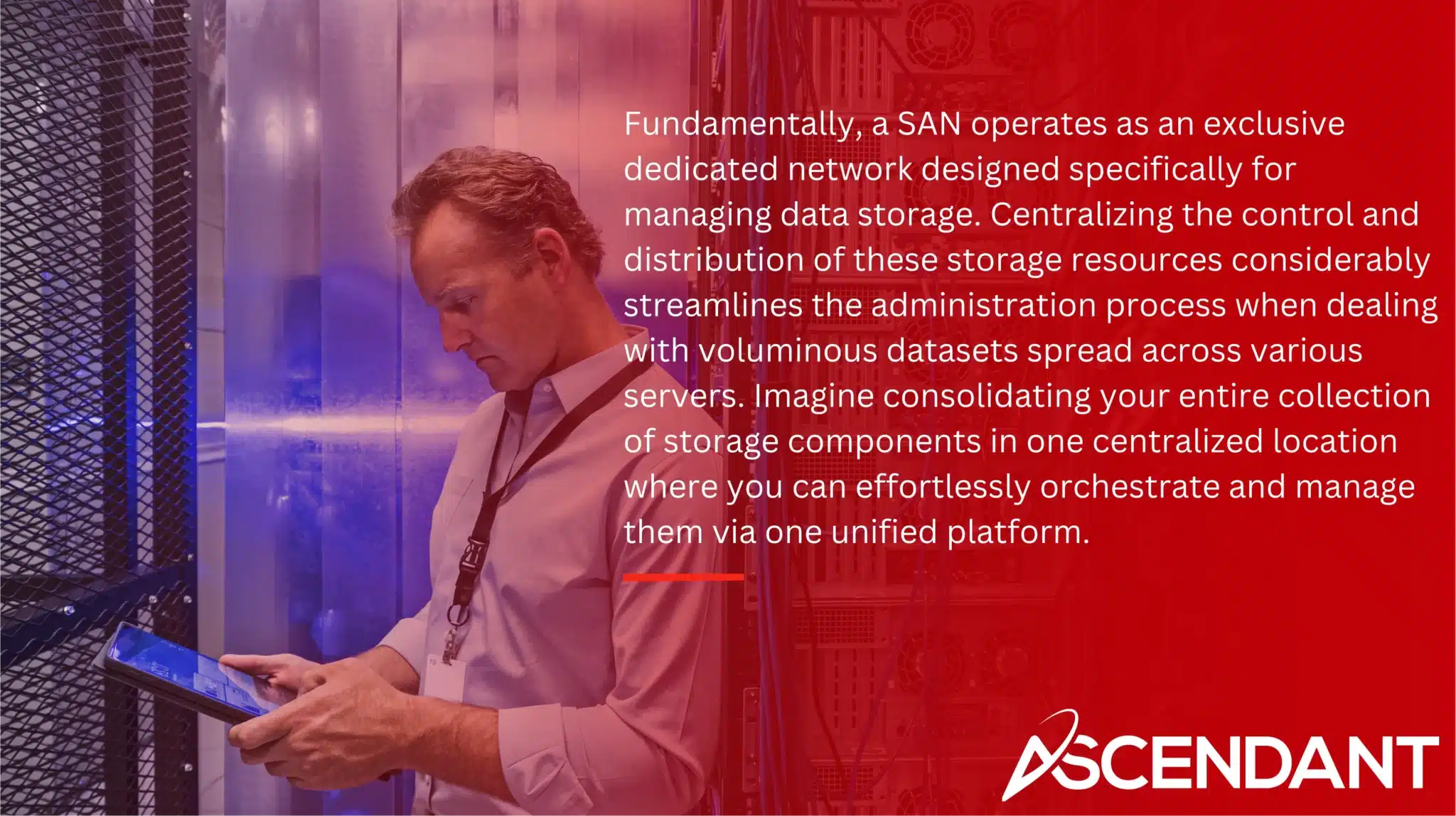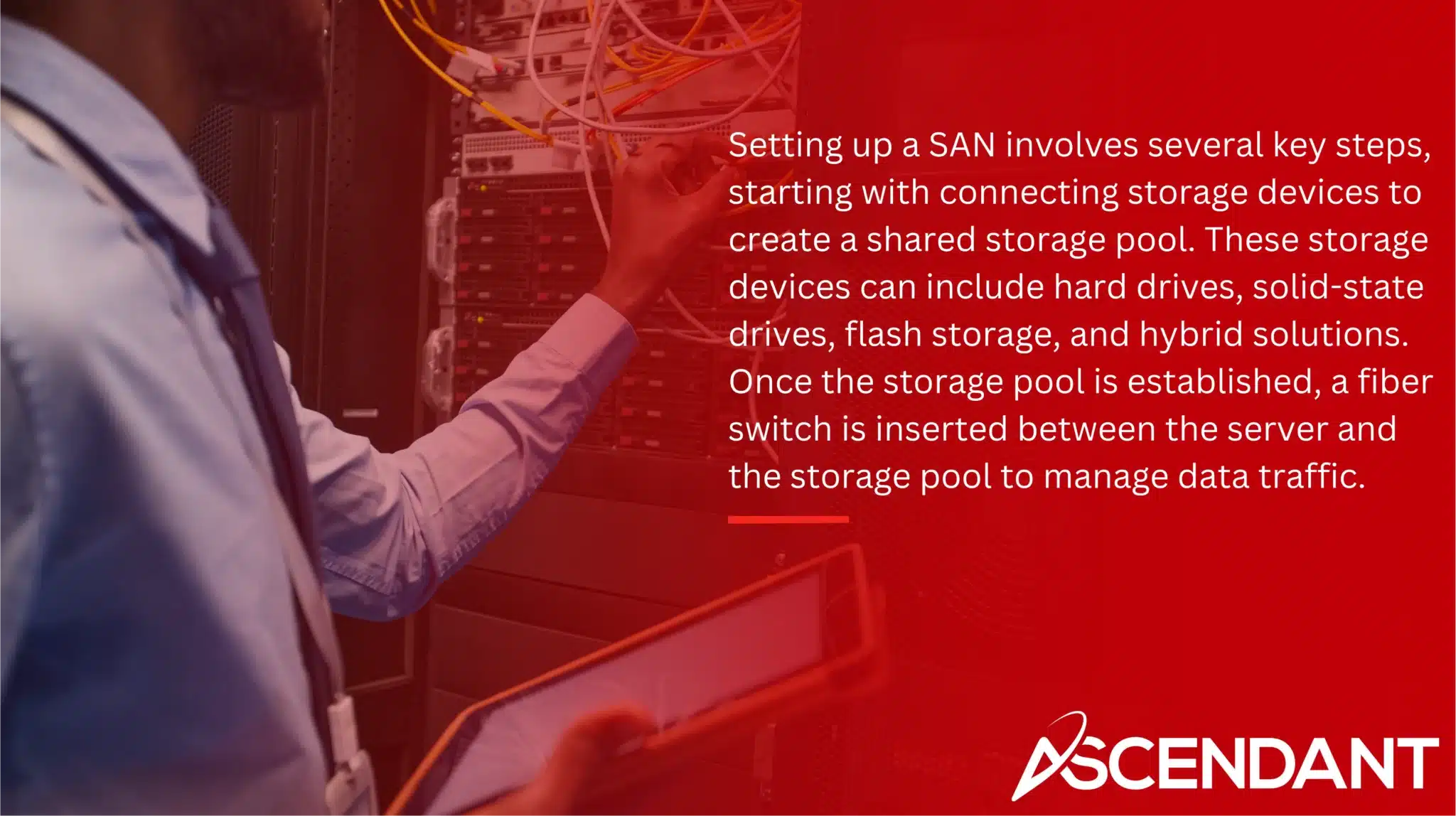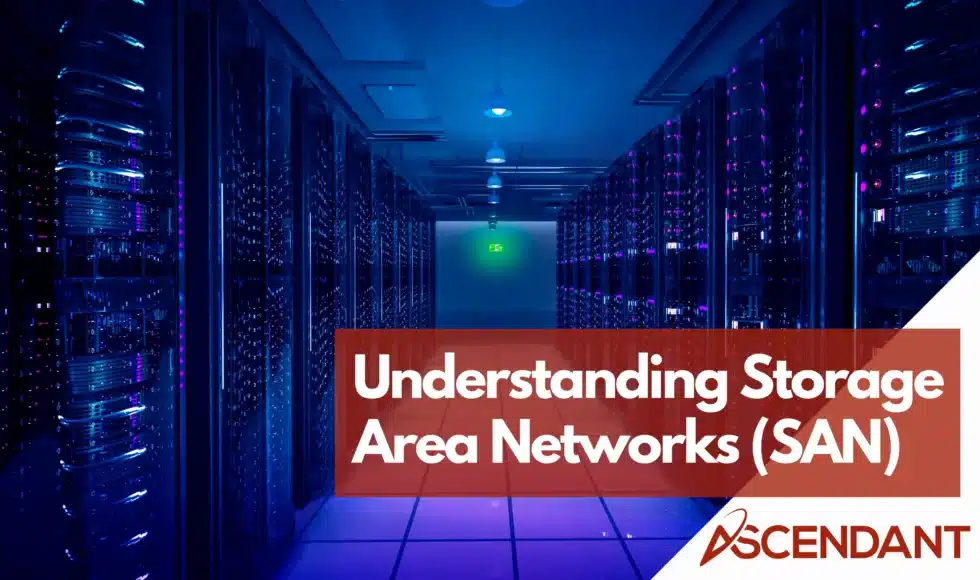A Storage Area Network (SAN) storage area network is a high-speed network that provides block-level access to storage for servers, allowing centralized management and high performance. Ideal for large-scale data environments, SANs support multiple servers, enhance data accessibility, and offer excellent scalability. This guide will cover SAN components, benefits, and comparisons with other storage solutions.
Key Takeaways
- A Storage Area Network (SAN) provides block-level access to storage devices, allowing multiple servers to access shared resources efficiently, which is essential for high-performance applications.
- Key components of a SAN include Host Bus Adapters, SAN switches, and storage arrays, working together to ensure reliable data transmission and management.
- Implementing a SAN enhances application performance, scalability, and reliability, but also introduces complexities that require dedicated IT management and careful architecture planning.
What is a SAN (Storage Area Network)?
A Storage Area Network (SAN) is a high-speed, specialized network that enables block-level access to storage devices. This contrasts with traditional network attached storage or direct attached storage solutions which handle file-based data over a network. SAN permits multiple servers the capability to utilize shared storage resources as though they were directly connected local disks, marking this block-level accessibility as a distinguishing feature of SAN among other types of data management systems.

Fundamentally, a SAN operates as an exclusive dedicated network designed specifically for managing data storage. Centralizing the control and distribution of these storage resources considerably streamlines the administration process when dealing with voluminous datasets spread across various servers. Imagine consolidating your entire collection of storage components in one centralized location where you can effortlessly orchestrate and manage them via one unified platform.
Emphasizing its functionality, SAN employs protocols like SCSI and iSCSI that support block-level transfer over its infrastructure, presenting the included storages within it to servers in logical disk formats for optimized performance and efficacy. The robust nature afforded by such capabilities renders Storage Area Networks especially suitable for scenarios demanding swift access rates and heightened reliability. Examples include database operations, virtual machine ecosystems, and intense transaction processing applications.
Key Components of SAN
A SAN is built upon several essential elements that collaborate to enable effective data storage and retrieval. The main components consist of:
- Host bus adapters (HBAs)
- Storage arrays
- SAN switches
- Cabling
These integral parts form the framework of a SAN, providing swift and reliable data transfer between servers and storage devices.
At the heart of the SAN’s design are its switches, critical in connecting servers to storage hardware and facilitating their communication. These devices manage how storage traffic flows throughout the system, ensuring both low latency for quick access times and high throughput for dealing with large volumes of data. Fibre Channel (FC) switches stand out as a popular choice within many SANs due to their ability to support numerous ports while allowing systems room to grow through modular design choices.
The fabric layer encompasses both cabling infrastructure and network equipment bridging hosts with storage solutions — this serves as an indispensable portion contributing significantly towards overall performance metrics such as speed or uptime guarantees afforded by a given SAN setup. It essentially carves out electronic channels which ferry information back-and-forth across different sections involved therein.
Various technologies like Fibre Channel, Ethernet or InfiniBand offer up distinctive advantages depending on considerations tied down either around budget constraints, expected transmission rates desired from one point onto another alongside scalability goals set forth at organizational levels – when these get pieced together accordingly, then they lay foundation stones able enough to configuring specialized robust Streamlined ‘SAN Solutions’ meant specifically meeting user-specific repository requirements.
How SAN Operates
Understanding the operation of a Storage Area Network (SAN) can be achieved by examining its three distinct layers: host, fabric, and storage. This tri-layer architecture enhances data management and accessibility by distinctly defining each layer’s role. At the host layer are servers that engage with storage devices, while network components like switches and cables form the fabric layer that interlinks these servers with storage arrays.
The significance of the fabric layer lies in its ability to furnish data transfer routes redundantly. This feature greatly boosts system dependability. The use of high-speed networks facilitates connections from servers to Logical Unit Numbers (LUNs), which appear as virtual drives on those servers—enabling swift access to data with reduced latency for enhanced operational efficiency.
For SAN communications, protocols such as Fibre Channel Protocol (FCP) and Internet Small Computer System Interface (iSCSI) are prevalent choices serving varied needs based on organizational context—with FCP being favored in scenarios demanding robust performance whereas iSCSI presents an economical option suitable for less extensive configurations.
Incorporating virtualization within SAN environments is pivotal—it permits presenting storage devices in a manner similar to direct attachment to hosts. This practice streamlines administrative tasks while amplifying agility across storage management operations.
SAN vs. NAS: Understanding the Differences
The key distinction between SAN and NAS resides in their respective structures and intended applications. A Storage Area Network (SAN) constitutes a localized network comprised of several storage devices, which provide block-level access to the stored resources. This configuration enables servers to interact with the SAN’s storage as though it were directly attached, rendering it highly beneficial for applications that necessitate rapid data retrieval and exhibit low latency demands.
Conversely, Network Attached Storage (NAS) usually employs a single storage device connected over a network designed primarily for straightforward file sharing and general-purpose storage tasks. While approximately two-thirds of all networked storage deployed belongs to SANs due to their performance capabilities, NAS systems are frequently selected by smaller enterprises or settings with less intensive requirements because they offer more affordability and simpler management features.
Benefits of Implementing SAN
Establishing a SAN brings about several improvements, most notably in the realm of application performance. By transferring storage duties to a high-speed network dedicated solely for this purpose, applications that depend on rapid and reliable data retrieval – such as those used for processing numerous transactions or video editing tasks – experience significant enhancements.
The ability of SANs to expand effortlessly marks another benefit over NAS systems which may falter under burgeoning demands. With their capacity to accommodate hundreds or even thousands of users at once, coupled with built-in redundancy and failover protocols, SANs provide robustness ensuring continuous operation and lessening chances of data loss—essential features for vital business functions where any downtime could result in considerable adverse effects.
SAN deployments offer additional benefits like adaptability and cost-efficiency, especially when they are merged with hyper-converged infrastructures. The incorporation of automation tools alongside capabilities for remote supervision helps simplify the running processes involved with SANs by decreasing manual labor requirements thereby curtailing potential human errors – all contributing elements solidifying SAN’s role as an integral component within enterprise environments focused on streamlining their storage systems.
Challenges and Considerations of SAN
Implementing a Storage Area Network (SAN) brings numerous advantages. It also presents particular difficulties. A significant obstacle is the intricate nature of SANs, which require specialized IT personnel for their management. This is in stark contrast to Network Attached Storage (NAS) systems that are typically manageable by individuals without technical expertise.
Selecting an appropriate SAN design and its components demands thorough deliberation from organizations to meet unique needs related to performance, cost-effectiveness, and system compatibility.
The importance of SANs extends into Business Continuity Management since they have the capability to cover several locations. This ability contributes additional complexity regarding their deployment and administration.
SAN Switches: Role and Importance
Storage Area Network (SAN) switches play an integral role in any storage network by linking servers to shared pools of storage. These specialized switches are exclusively tasked with handling the movement of storage traffic, which allows for streamlined data transfer between a variety of servers and storage devices. This separation provided by SAN switches leads to more effective data management and heightened performance across the system.
Fibre Channel (FC) is the leading type of switch implemented within SAN environments because it supports high port counts and can be configured modularly. For instance, Cisco’s MDS 9000 series multilayer SAN switches aim at lowering ownership costs while boosting storage administration efficacy. Such advanced features position SAN switches as crucial elements necessary for maintaining highly efficient storage networks.
Setting Up a SAN

Setting up a SAN involves several key steps, starting with connecting storage devices to create a shared storage pool. These storage devices can include hard drives, solid-state drives, flash storage, and hybrid solutions. Once the storage pool is established, a fiber switch is inserted between the server and the storage pool to manage data traffic.
Next, each server and storage device must be equipped with a Host Bus Adapter (HBA) card to enable effective communication within the SAN. The SAN software then manages the interface between client servers, connectivity devices, and storage pools, ensuring efficient operation. Copper cables can be used for cost-effective connections, while fiber cables are preferred for high-speed data transmission.
Understanding an organization’s storage needs and future data growth expectations is crucial when implementing a SAN solution. Using standard x86 or x64 server hardware with free SAN software can also help build a cost-effective SAN. Following these steps while considering the organization’s specific requirements helps establish a robust and efficient SAN.
Advanced SAN Technologies
Revolutionary SAN technologies are redefining how storage is managed, yielding increased efficiency and functionality. For example, virtual SAN technology creates logical divisions within an actual physical SAN, which enhances both the control of data flow and system protection. This innovation empowers businesses to maximize the use of their storage assets while bolstering data segregation.
Converged SAN takes advantage of Ethernet components to cut down costs and streamline network complexities without compromising performance. It melds processing power with storage capabilities in a unified modular setup that can be easily expanded and controlled. Hyper-converged infrastructure pushes this concept even further. By amalgamating computing resources, storage capacity, and networking into one cohesive unit.
In total, these sophisticated technologies are revolutionizing our approach to managing all the storage resources at hand. They afford organizations heightened versatility in terms of storing capacities as well as more potent solutions for coping with continuous shifts in their data demands—ultimately leading to better utilization rates when it comes time to store information using san technology-based infrastructures. These advancements not only keep enterprises competitive, but also gear up their storage networks for forthcoming challenges.
Major SAN Vendors and Products
Cisco is recognized as a key player in the SAN marketplace, renowned for its sophisticated networking solutions. Its MDS SAN offering allows for NVMe/FC support directly, eliminating the necessity of extra hardware or command inputs to integrate with current SAN systems. This seamless compatibility improves transitions while boosting storage efficiency and management.
Designed to lower ownership costs and enhance storage administration, Cisco’s offerings in the realm of SAN products are highly regarded by enterprises aiming to refine their storage networks. Employing Cisco’s cutting-edge SAN networking devices enables companies to attain elevated performance levels, expand scalability options, and streamline data handling processes.
Best Practices for SAN Management
To guarantee efficient SAN management, it’s essential to consistently monitor and analyze the system. This ensures peak performance while preemptively tackling possible problems. Incorporating advanced features in SAN switches like bandwidth autosensing, path redundancy, and network diagnostics is crucial for managing traffic flow adeptly. By leveraging these capabilities, a SAN can maintain seamless operations and cater to its workload effectively.
Maintaining an accurate record of the configurations and components within a SAN is also critical for ongoing maintenance efforts and expedient problem-solving. Comprehensive documentation enables organizations to swiftly pinpoint issues that arise, thereby reducing downtime and maintaining uninterrupted access to data.
Embracing established practices such as consistent data replication strategies along with comprehensive disaster recovery plans reinforces a SAN’s dependability and functionality. High availability setups are particularly effective in safeguarding precious data assets while ensuring key applications stay up-and-running even amidst failures or disruptions.
Future Trends in SAN Technology
Several trends are redefining the landscape of SAN technology, notably through the introduction of NVMe across Fibre Channel (FC). This innovation delivers superior performance and diminished latency by harnessing Non-Volatile Memory to accelerate data transmission rates. Advancements in Fibre Channel technologies reaching speeds up to 128GFC are propelling significant gains in SAN throughput.
The integration of Artificial Intelligence (AI) within SAN frameworks is enhancing their capabilities with predictive analytics that bolster monitoring, diagnostics, and problem-solving functions. The insights generated from AI enable organizations to refine their storage infrastructure for heightened efficiency.
In anticipation of forthcoming enhancements in SAN technology, enterprises must gear up for 64G Fibre Channel while also implementing machine learning algorithms. Such developments will afford swifter data accessibilities and escalated bandwidths alongside reinforced business continuity measures – keeping SAN systems at the pinnacle of data storage options.
Summary
To encapsulate, Storage Area Networks (SAN) present a powerful and expandable framework for the management and retrieval of substantial data quantities. This manual has delivered an all-encompassing insight into SAN technology, from grasping its foundational elements and mechanics to delving into cutting-edge innovations and prospective directions. By adhering to best practices and keeping pace with new developments, businesses can refine their storage infrastructure while ensuring superior efficiency, dependability, and extendibility.
As our digital environment progresses relentlessly forward, SAN will continue to be an indispensable segment of IT frameworks by empowering enterprises in the handling of their information more proficiently thereby maintaining a competitive edge in today’s intensively data-centric commercial sphere. Adopting SAN solutions as well as following the recommendations provided herein empowers organizations to fully leverage their storage resources towards realizing key goals.
Frequently Asked Questions
What is the primary difference between SAN and NAS?
SAN provides servers with block-level access to storage, allowing them to treat the storage as if it were local disks. In contrast, NAS allows for file-level access, which is ideal for convenient sharing of general-purpose files.
Why is SAN preferred in high-performance environments?
Due to its ability to offer rapid data access and low latency, SAN is the system of choice in environments that demand high performance. These characteristics are critical for applications that require intense processing power, such as databases with a high volume of transactions and video editing tasks.
This superior level of performance substantially improves the efficiency of operations across the board.
What role do SAN switches play in a SAN setup?
SAN switches are crucial in a SAN setup as they connect servers to shared storage pools, managing data exchange and ensuring efficient data transmission between storage devices and servers.
This facilitates optimal performance and resource utilization within the network.
How does SAN enhance data accessibility and manageability?
By centralizing storage management, a SAN (Storage Area Network) boosts data accessibility and manageability. It enables easier control and distribution of storage resources among several servers.
The process simplifies the approach to accessing data and enhances the efficiency with which data is managed overall.
What are some advanced SAN technologies transforming traditional storage solutions?
Advanced SAN technologies such as virtual SANs, converged SAN, and hyper-converged infrastructure are significantly enhancing efficiency, scalability, and performance in traditional storage solutions.
The adoption of these technologies can lead to substantial improvements in your storage management capabilities.


